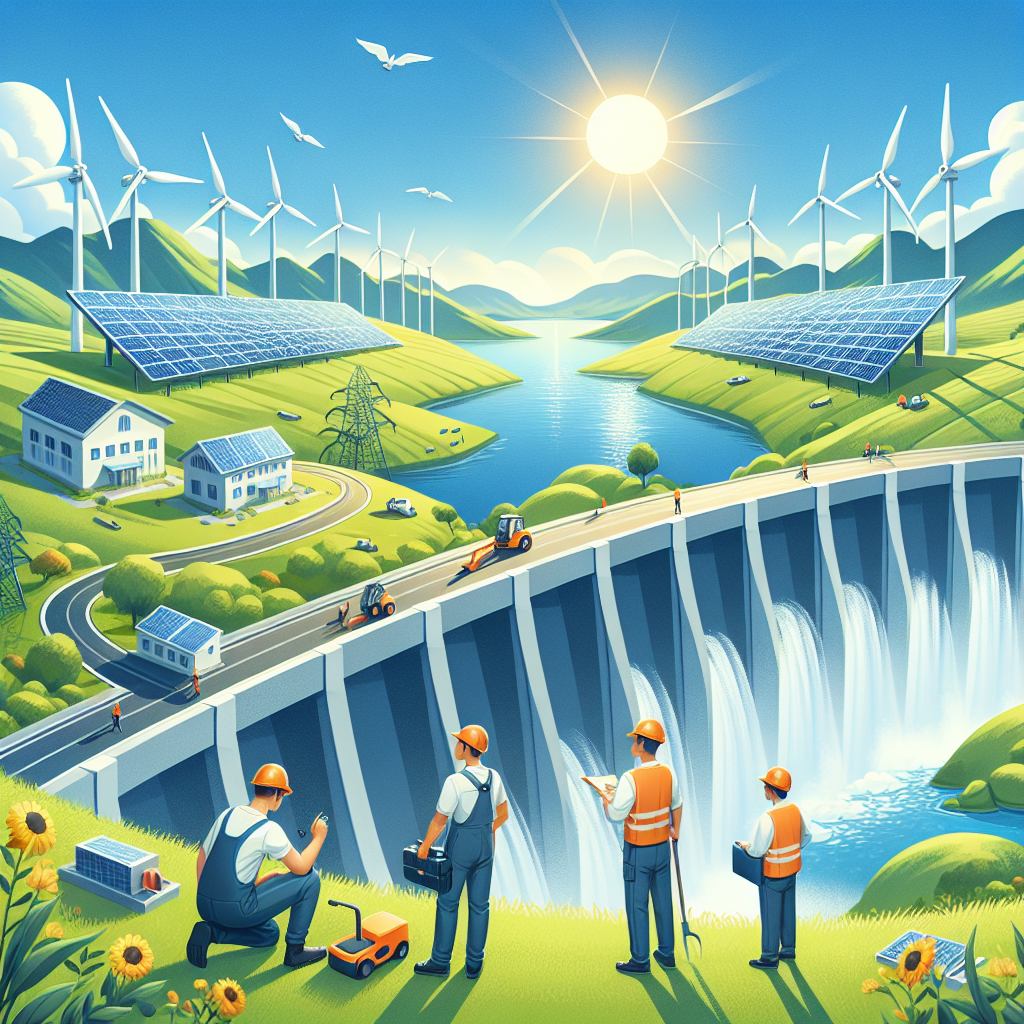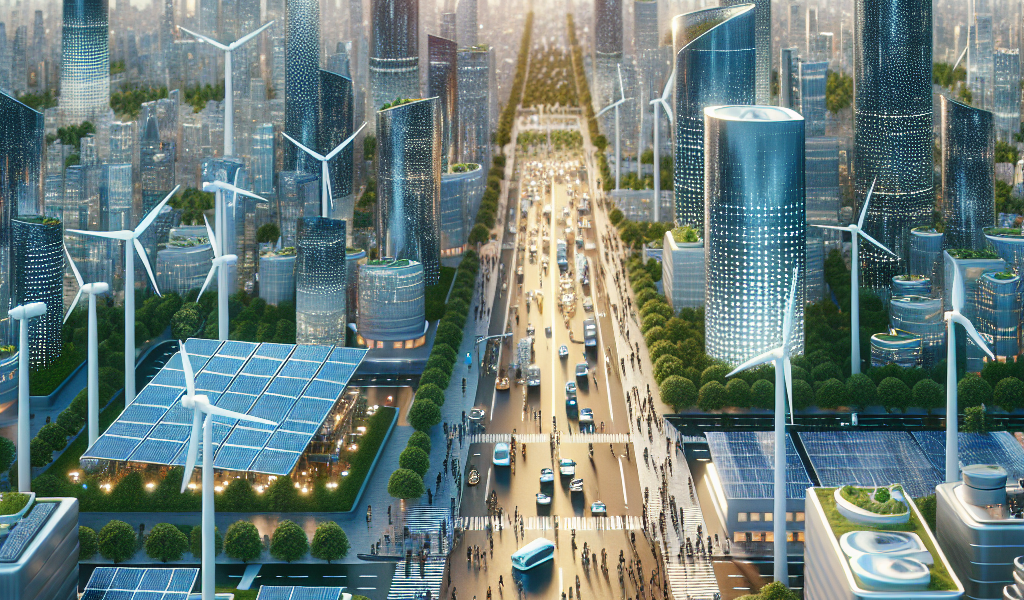-
Table of Contents
“Unleashing the Future: The Power of Renewable Energy Technologies”
Introduction

Exploring the Impact of Renewable Energy Technologies
The global energy landscape is undergoing a transformative shift as the urgency to address climate change and reduce greenhouse gas emissions intensifies. Renewable energy technologies, encompassing solar, wind, hydro, and geothermal power, are at the forefront of this transition, offering sustainable alternatives to fossil fuels. This exploration delves into the multifaceted impact of renewable energy technologies, examining their potential to revolutionize energy systems, drive economic growth, and foster environmental sustainability. By analyzing advancements, challenges, and policy implications, this study aims to provide a comprehensive understanding of how renewable energy technologies are reshaping the future of energy production and consumption.
The Role of Solar Power in Reducing Carbon Emissions
Solar power has emerged as a cornerstone in the global effort to reduce carbon emissions, offering a sustainable alternative to fossil fuels. As the world grapples with the pressing need to combat climate change, the role of solar energy in mitigating environmental impact cannot be overstated. This renewable energy source harnesses the sun’s abundant power, converting it into electricity without emitting greenhouse gases. Consequently, solar power presents a viable solution to the carbon-intensive practices that have long dominated energy production.
One of the most significant advantages of solar power is its potential to drastically cut carbon emissions. Traditional energy sources, such as coal and natural gas, release substantial amounts of carbon dioxide and other pollutants into the atmosphere. In contrast, solar panels generate electricity without burning fuel, thereby eliminating the associated emissions. This shift from fossil fuels to solar energy can lead to a marked reduction in the carbon footprint of both residential and commercial sectors. Moreover, as technology advances, the efficiency of solar panels continues to improve, making them an increasingly attractive option for energy consumers.
In addition to reducing carbon emissions, solar power offers economic benefits that further bolster its appeal. The cost of solar panels has plummeted over the past decade, making it more accessible to a broader range of consumers. Government incentives and subsidies have also played a crucial role in promoting the adoption of solar technology. These financial incentives, coupled with the long-term savings on energy bills, make solar power an economically sound investment. As more households and businesses transition to solar energy, the cumulative effect on carbon emissions becomes even more pronounced.
Furthermore, the decentralized nature of solar power generation contributes to its environmental benefits. Unlike centralized power plants, which often require extensive infrastructure and long-distance transmission lines, solar panels can be installed directly on rooftops or in local solar farms. This localized approach reduces the energy lost during transmission and minimizes the need for land disruption. Additionally, it empowers communities to become more self-sufficient in their energy needs, fostering a sense of environmental stewardship and responsibility.
The integration of solar power into the energy grid also enhances its reliability and resilience. Solar energy can be stored in batteries for use during periods of low sunlight, ensuring a consistent power supply. This capability is particularly valuable in regions prone to natural disasters or grid disruptions, where solar power can provide a reliable backup source of electricity. By diversifying the energy mix and reducing dependence on fossil fuels, solar power contributes to a more stable and resilient energy infrastructure.
Despite these advantages, the widespread adoption of solar power faces several challenges. Initial installation costs, although decreasing, can still be a barrier for some consumers. Additionally, the intermittent nature of solar energy—dependent on weather and daylight—necessitates the development of efficient storage solutions and grid management systems. However, ongoing research and innovation in the field of renewable energy are steadily addressing these issues, paving the way for broader implementation.
In conclusion, solar power plays a pivotal role in reducing carbon emissions and combating climate change. Its environmental and economic benefits make it a compelling alternative to traditional energy sources. As technology continues to advance and costs decline, the adoption of solar power is likely to accelerate, contributing to a cleaner, more sustainable future. By embracing solar energy, we take a significant step towards mitigating the impacts of climate change and ensuring a healthier planet for future generations.
Wind Energy: Transforming the Future of Sustainable Power
Wind energy is rapidly transforming the landscape of sustainable power, offering a promising solution to the global challenge of reducing carbon emissions and combating climate change. As the world increasingly turns its attention to renewable energy sources, wind power stands out for its potential to generate electricity without the harmful byproducts associated with fossil fuels. This shift towards wind energy is not only a testament to technological advancements but also a reflection of growing environmental consciousness and policy support.
One of the most compelling aspects of wind energy is its ability to harness a natural, inexhaustible resource. Wind turbines, which convert kinetic energy from the wind into electrical power, have become a common sight in many parts of the world. These towering structures, often located in rural areas or offshore, symbolize a move towards cleaner energy production. The efficiency and capacity of wind turbines have improved significantly over the years, making wind energy a more viable and competitive option compared to traditional energy sources.
Moreover, the environmental benefits of wind energy are substantial. Unlike coal or natural gas plants, wind turbines do not emit greenhouse gases or other pollutants during operation. This means that as more wind farms are developed, the overall carbon footprint of electricity generation can be significantly reduced. Additionally, wind energy requires no water for cooling, unlike many conventional power plants, which helps conserve this precious resource and reduces the impact on local ecosystems.
Economic factors also play a crucial role in the adoption of wind energy. The cost of wind power has decreased dramatically over the past decade, driven by technological advancements and economies of scale. As a result, wind energy is becoming increasingly cost-competitive with fossil fuels. This economic viability is encouraging both private and public investments in wind projects, further accelerating the transition to renewable energy. In many regions, wind farms are creating jobs and stimulating local economies, providing a much-needed boost to rural communities.
However, the expansion of wind energy is not without its challenges. One of the primary concerns is the intermittency of wind; it does not blow consistently, which can lead to fluctuations in power generation. To address this issue, advancements in energy storage technologies, such as batteries, are being developed to store excess energy generated during windy periods for use when the wind is calm. Additionally, integrating wind power into existing electrical grids requires careful planning and infrastructure upgrades to ensure reliability and stability.
Public perception and acceptance of wind energy also play a significant role in its development. While many people support the idea of clean energy, there are often concerns about the visual and noise impact of wind turbines, as well as their effect on wildlife, particularly birds and bats. To mitigate these concerns, ongoing research and innovation are focused on designing quieter, more efficient turbines and implementing measures to protect wildlife.
In conclusion, wind energy is poised to play a pivotal role in the future of sustainable power. Its environmental benefits, economic potential, and technological advancements make it a key component of the global effort to transition away from fossil fuels. While challenges remain, continued investment and innovation in wind energy technologies promise to overcome these hurdles, paving the way for a cleaner, more sustainable energy future. As we look to the horizon, the sight of wind turbines spinning gracefully in the breeze offers a hopeful vision of what is possible when we harness the power of nature for the greater good.
Innovations in Hydroelectric Technology and Their Environmental Benefits
In recent years, the global push towards sustainable energy solutions has led to significant advancements in renewable energy technologies. Among these, hydroelectric power has emerged as a key player, offering a reliable and efficient source of clean energy. Innovations in hydroelectric technology are not only enhancing energy production but also providing substantial environmental benefits, making it a crucial component in the fight against climate change.
One of the most notable innovations in hydroelectric technology is the development of small-scale hydroelectric systems. Unlike traditional large dams, which can have significant ecological and social impacts, small-scale hydroelectric systems are designed to minimize disruption to local ecosystems. These systems can be installed in smaller rivers and streams, harnessing the natural flow of water to generate electricity without the need for large reservoirs. This approach not only reduces the environmental footprint but also makes hydroelectric power accessible to remote and rural communities, promoting energy equity.
Moreover, advancements in turbine technology have played a pivotal role in increasing the efficiency and sustainability of hydroelectric power. Modern turbines are designed to operate at lower water flow rates, which means they can generate electricity even during periods of drought or low water levels. This adaptability ensures a more consistent energy supply and reduces the need for backup fossil fuel power plants. Additionally, new turbine designs are being developed to minimize harm to aquatic life, addressing one of the longstanding environmental concerns associated with hydroelectric power.
Another significant innovation is the integration of hydroelectric systems with other renewable energy sources. For instance, hybrid systems that combine hydroelectric power with solar or wind energy are becoming increasingly popular. These systems can balance the intermittent nature of solar and wind power with the steady output of hydroelectric plants, creating a more reliable and resilient energy grid. This synergy not only maximizes the use of available renewable resources but also reduces the reliance on non-renewable energy sources, further decreasing greenhouse gas emissions.
Furthermore, the implementation of advanced monitoring and control systems has revolutionized the management of hydroelectric plants. These systems use real-time data and predictive analytics to optimize water flow and energy production, ensuring maximum efficiency and minimal environmental impact. By precisely controlling the release of water, these technologies help maintain river ecosystems and support biodiversity, while also preventing downstream flooding and erosion.
In addition to technological advancements, policy and regulatory frameworks are evolving to support the sustainable development of hydroelectric power. Governments and international organizations are increasingly recognizing the importance of protecting water resources and promoting environmentally friendly practices. Incentives such as grants, tax credits, and favorable tariffs are being introduced to encourage the adoption of innovative hydroelectric technologies. These measures not only drive technological progress but also foster a collaborative approach to sustainable energy development.
The environmental benefits of these innovations are manifold. By reducing the need for large dams and reservoirs, small-scale hydroelectric systems help preserve natural habitats and protect wildlife. Improved turbine designs and advanced monitoring systems mitigate the impact on aquatic life, ensuring the health of river ecosystems. The integration of hydroelectric power with other renewable sources contributes to a more stable and sustainable energy grid, reducing carbon emissions and combating climate change.
In conclusion, the advancements in hydroelectric technology are paving the way for a more sustainable and environmentally friendly energy future. By embracing these innovations, we can harness the power of water in a way that benefits both people and the planet. As we continue to explore and develop new technologies, the potential for hydroelectric power to contribute to a cleaner, greener world becomes increasingly clear.
Conclusion
The exploration of the impact of renewable energy technologies reveals significant benefits, including the reduction of greenhouse gas emissions, enhancement of energy security, and stimulation of economic growth through job creation and technological innovation. These technologies, such as solar, wind, and hydroelectric power, offer sustainable alternatives to fossil fuels, contributing to environmental preservation and the mitigation of climate change. However, challenges such as high initial costs, intermittency issues, and the need for substantial infrastructure development must be addressed to fully realize their potential. Overall, the transition to renewable energy is crucial for achieving a sustainable and resilient energy future.





